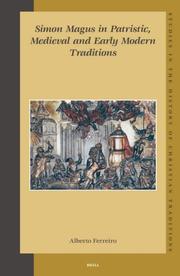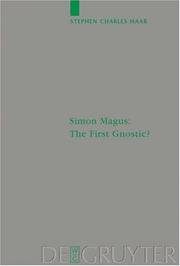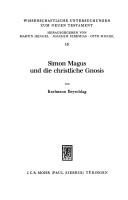| Listing 1 - 10 of 12 | << page >> |
Sort by
|
Article
Year: 1979 Publisher: Gembloux : J. Duculot,
Abstract | Keywords | Export | Availability | Bookmark
 Loading...
Loading...Choose an application
- Reference Manager
- EndNote
- RefWorks (Direct export to RefWorks)
Book
ISBN: 3525873514 9783525873519 Year: 1975 Volume: 1 Publisher: Göttingen Vandenhoeck und Ruprecht
Abstract | Keywords | Export | Availability | Bookmark
 Loading...
Loading...Choose an application
- Reference Manager
- EndNote
- RefWorks (Direct export to RefWorks)
Gnosticism --- Simon Magus --- #GROL:SEMI-22:21 --- Simon Magus. --- Cults

ISSN: 15735664 ISBN: 9004144951 9047415469 9789004144958 9789047415466 Year: 2005 Volume: 125 Publisher: Leiden; Boston : BRILL
Abstract | Keywords | Export | Availability | Bookmark
 Loading...
Loading...Choose an application
- Reference Manager
- EndNote
- RefWorks (Direct export to RefWorks)
The volume discusses the post-New Testament Simon Magus from the era of the Church Fathers beginning with Justin Martyr to the early modern era represented in a seventeenth century Baroque relief in the Cathedral of Oviedo, Spain. Sources consulted are artistic, theological texts, historical chronicles, sermons, hagiographies, vernacular literatures, biblical commentaries, and heresiologies. Topics explored are: Traditions and Historiography; Types of Simon Magus in Anti-Gnostic sources; a comparison of the Acts of Peter and the Passions of the Holy Apostles Peter and Paul ; Jerome and Vincent of Lérins on Simon Magus; the Nicolaitian heresy; the Fall of Simon Magus in the Church Fathers; Simon Magus, Dogs, and Simon Peter; Simon Magus in Irish and English medieval legends; Simon Magus, Nicolas of Antioch, and Muhammad; Vincent Ferrer and the canonical and apocryphal Simon Magus; Simon Magus in the Cathedral of León, Spain; Simon Magus in the Cathedral of Oviedo, Spain; and a full bibliographical inventory- 99 entries- of Simon Magus in artistic expression. The book is illustrated with about 28 artistic reproductions. The volume contains author and subject indexes and a full bibliography of works consulted.
Simon, --- Patristique --- Simon Magus --- Simon, - Magus, - 1st cent. --- Cultural influences --- Simon Magus,

ISBN: 3110176890 3111869601 3110898829 9783110898828 9783110176896 Year: 2003 Volume: 119 Publisher: Berlin de Gruyter
Abstract | Keywords | Export | Availability | Bookmark
 Loading...
Loading...Choose an application
- Reference Manager
- EndNote
- RefWorks (Direct export to RefWorks)
Diese neue umfassende Studie zu Simon Magus verleiht der Erforschung der frühen Christenheit und den Fragen nach Herkunft und Wesen des Gnostizismus neuen Nachdruck. Der Autor geht dabei von der traditionellen Exegese von Act 8,5-24 - der ersten narrativen Quelle zu Simon - und den späteren Berichten antiker christlicher Schriftsteller aus. In einem Überblick zur Literatur der griechisch-römischen Antike wird der Einfluss der Begriffe "magisch" und "die Magier" auf die Wahrnehmung und Beschreibung Simons bestimmt. Schließlich bezieht der Autor sozialwissenschaftliche Erklärungsmodelle und moderne Bestimmungen von "Identität" ein und gibt damit der Diskussion um das Phänomen Simons neue Impulse. This latest comprehensive work on Simon Magus lends new impetus to the investigation of Early Christianity and questions surrounding the origin and nature of Gnosticism. Major contributions of this study include: (1), a departure from the traditional exegesis of Acts 8, 5-24 (the first narrative source of Simon), and the later following reports of ancient Christian writers; (2), an overview of the literature of Graeco-Roman antiquity to determine the contribution of "magic" and "the Magoi" in the development of perceptions and descriptions of Simon; and (3), the inclusion of social science explanation models and modern estimations of "identity", in a creative approach to questions surrounding the phenomenon of Simon.
Gnosticism --- 273.1 SIMON MAGUS --- Gnosis. Gnosticisme--SIMON MAGUS --- Theses --- 273.1 SIMON MAGUS Gnosis. Gnosticisme--SIMON MAGUS --- Simon, --- Simon Magus, --- Cults --- Gnosticism.
Book
ISBN: 9782701022895 2701022894 Year: 2019 Volume: 7 Publisher: Paris : Beauchesne,
Abstract | Keywords | Export | Availability | Bookmark
 Loading...
Loading...Choose an application
- Reference Manager
- EndNote
- RefWorks (Direct export to RefWorks)
L'un des plus grands mythes de notre littérature trouve son origine historique dans un personnage fantasque, mi-charlatan, mi-homme de science et de culture, le docteur Faust de Kundling. Mais les développements littéraires qui ont suivi sa mort singulière se sont appuyés sur différentes figures qui appartiennent au fonds commun de notre culture occidentale. Au premier rang d'entre elles, celle de Simon le Magicien, connue à travers les Actes des apôtres, la tradition hérésiologique (Justin, Irénée), et surtout le Roman pseudo-clémentin. C'est en effet dans cet ouvrage que l'auteur du premier récit sur Faust, le Faustbuch (1587), a puisé nombre des traits qu'il attribue à son anti-héros : le nom même de Faustus (bien attesté par ailleurs comme patronyme du magicien), les pratiques magiques et l'asservissement au démon, mais aussi la présence à ses côtés d'Hélène de Troie, la compagne de Simon. Cette confusion permit à l'auteur une nouvelle assimilation, celle de Faust avec le pape Alexandre VI Borgia, coupable de simonie. L'ouvrage retrace ce parcours littéraire, depuis les Actes des apôtres jusqu'au Faustbuch et quelques-uns des auteurs qui s'en sont inspirés (Marlowe, Goethe, Flaubert, Anatole France).
Simon, --- Faust, --- Faust --- In literature. --- Historia von Doctor Johann Fausten. --- Simon Magus --- Clemens I p. m. --- Pseudoclementina --- Simon, - Magus, - active 1st century. --- Simon, - Magus, - active 1st century - In literature. --- Faust, - -approximately 1540. --- Faust - (Legendary character) --- Simon, - Magus, - active 1st century

ISBN: 3161358724 9783161358722 Year: 1974 Volume: 16 Publisher: Tübingen Mohr Siebeck
Abstract | Keywords | Export | Availability | Bookmark
 Loading...
Loading...Choose an application
- Reference Manager
- EndNote
- RefWorks (Direct export to RefWorks)
Gnosticism --- Simon Magus --- 273.1*1 --- #GROL:SEMI-22:21 --- Gnosis en Bijbel --- 273.1*1 Gnosis en Bijbel --- Gnose. --- Gnosis. --- Gnosticism. --- Gnosticisme. --- Handelingen der Apostelen (bijbelboek). --- Simon le Magicien. --- Simon, --- Simon Magus. --- Cults
Book
ISBN: 9783515130134 9783515130103 3515130101 3515130136 Year: 2021 Publisher: Stuttgart: Franz Steiner,
Abstract | Keywords | Export | Availability | Bookmark
 Loading...
Loading...Choose an application
- Reference Manager
- EndNote
- RefWorks (Direct export to RefWorks)
Die Pseudoklementinen sind ein autobiographischer Bildungsroman der Spätantike. Dieser erste christliche Roman ist in zwei verschiedenen Versionen überliefert, den griechischen Homilien und den lateinischen Rekognitionen. Die Handlung verläuft in beiden Fassungen jedoch weitgehend gleich: Klemens, der Ich-Erzähler und spätere Bischof von Rom, beschreibt die Erlebnisse seiner Reise mit dem Apostel Petrus durch Judäa und Syrien. Die Hauptpersonen diskutieren theologische und philosophische Grundfragen wie Monotheismus versus Polytheismus oder menschliche Willensfreiheit versus astrologischen Determinismus. Die Rekognitionen, die Rufinus von Aquileia im 5. Jahrhundert aus dem Griechischen ins Lateinische übersetzte, sind nach den Wiedererkennungen (recognitiones) benannt, durch welche die über den Mittelmeerraum verstreuten Eltern und Geschwister des Ich-Erzählers wieder vereint werden.Der Roman hatte einen festen Platz in der europäischen Geistes- und Kulturgeschichte. Mit der Übersetzung der beiden ersten Bücher der Pseudoklementinen eröffnet Meinolf Vielberg die erste vollständige lateinisch-deutsche Ausgabe und erschließt den historischen und literarischen Kontext durch erläuternde Kommentare
(Produktform)Hardback --- Pseudoklementinen --- Rekognitionen --- Homilien --- Klemens von Rom --- Clemens Romanus --- Petrus --- Geschichte des frühen Christentums --- Apostelgeschichte --- Bischof von Rom --- Geschichte des Judentums --- Rufinus von Aquileia --- erster christlicher Roman --- antiker Roman --- Romanmotive --- Astrologie --- Magie --- Simon Magus --- christliche Apokryphen --- Übersetzung --- Mehrsprachigkeit --- Anfang der syrischen Literatur --- Bardesanes --- Monotheismus --- Polytheismus --- Jerusalem --- Caesarea --- Antiochien --- Rom --- (VLB-WN)1567: Hardcover, Softcover / Sprachwissenschaft, Literaturwissenschaft/Klassische Sprachwissenschaft, Literaturwissenschaft --- Clemens I p. m. --- Pseudoclementina
Book
ISBN: 9783110240580 3110240580 9783110240597 1282716166 9786612716164 3110240599 9783110217315 3110217317 3110208083 9783110208085 9781282716162 6612716169 Year: 2010 Volume: 96 Publisher: Berlin New York Walter de Gruyter
Abstract | Keywords | Export | Availability | Bookmark
 Loading...
Loading...Choose an application
- Reference Manager
- EndNote
- RefWorks (Direct export to RefWorks)
Ausgangspunkt dieses in zweiter Auflage durchgesehenen und ergänzten Bandes ist ein Exkurs im Bellum Iudaicum des hier dem Ambrosius zugeschriebenen sog. Hegesippus über den Wettstreit des Petrus mit Simon Magus in Rom und die sich daran anschließende Christenverfolgung Neros, in der die Apostel Petrus und Paulus das Martyrium erleiden. Die Frage nach den Quellen dieser Episode und deren Historizität führt zu einer Überprüfung der "Schlüsselbeweise" für einen Aufenthalt des Petrus in Rom und der sonstigen literarischen Zeugnisse vom Neuen Testament bis in die Spätantike. Im Vordergrund stehen die apokryphen Apostelakten, der 1. Clemensbrief, Iustinus Martyr, Dionysios von Korinth, Polykarp von Smyrna und die Antihäretiker Hegesippus und Irenäus von Lyon. Die vermeintlich echten Briefe des Ignatius von Antiochien werden in den Rahmen christlicher und heidnischer Pseudepigrapha der Zweiten Sophistik eingeordnet, ihre Entstehungszeit auf das Jahrzehnt 170-180 festgelegt. Ein breites Kapitel ist philologischen Untersuchungen zur Datierung des 1. Clemensbriefes und der Spätschriften des Neuen Testamentes gewidmet. Am Ende steht eine kritische Edition (mit Übersetzung) der Martyrien des Petrus und des Paulus unter Berücksichtigung einer hier erstmalig eingeführten griechischen Handschrift, die ein bisher nicht bekanntes Selbstporträt des Paulus enthält.
Apocryphal Acts of the Apostles --- Criticism, interpretation, etc --- Peter, --- Paul, --- Simon, --- Homes and haunts --- Death and burial --- In literature --- Passio Petri et Pauli --- Martyrologies --- Actes apocryphes des Apôtres --- Martyrologes --- Commentaries --- History and criticism. --- Commentaires --- Histoire et critique --- Clement --- Pseudo-Ignatius, --- Passio Petri et Pauli. --- Acta Pauli / Martyrium Pauli. --- Acta Petri / Martyrium Petri. --- Apocryphal Acts of the Apostles --Criticism, interpretation, etc. --- Clement --I, --Pope. --First epistle of Clement to the Corinthians. --- Martyrologies --History and criticism. --- Paul, --the Apostle, Saint. --- Peter, --the Apostle, Saint --Death and burial. --- Peter, --the Apostle, Saint --Homes and haunts --Rome. --- Peter, --the Apostle, Saint --In literature. --- Peter, --the Apostle, Saint --Legends. --- Pseudo-Ignatius, --of Antioch. --- Simon, --Magus, --1st cent. --- Acts (Apocryphal books) --- Acts of the Apostles (Apocryphal books) --- Cephas, --- Pedro, --- Pietro, --- Simon Bar Jona, --- Simon Peter, --- Simon Petrus, --- Christianity --- Religion --- Philosophy & Religion --- History and criticism --- Petrus, --- Necrologies --- Apocryphal books (New Testament) --- Criticism, interpretation, etc. --- Christenverfolgungen. --- Erster Clemensbrief. --- First Clement. --- Ignatius of Antioch. --- Ignatius von Antiochien. --- Neues Testament. --- New Testament. --- Persecution of Christians. --- Simon Magus. --- RELIGION / Bible / General. --- Petrus --- Pierre --- Peter --- Acta Pauli --- Acta Petri --- Rom. --- Apocryphal Acts of the Apostles - Criticism, interpretation, etc. --- Petrus ap. --- Romae commoratio --- Peter, - the Apostle, Saint - Homes and haunts - Rome --- Peter, - the Apostle, Saint - Death and burial --- Peter, - the Apostle, Saint - In literature --- Peter, - the Apostle, Saint - Legends --- Paul, - the Apostle, Saint --- Simon, - Magus, - active 1st century --- Peter, - the Apostle, Saint
Book
ISSN: 18621112 ISBN: 9783110208085 3110208083 9786612372483 1282372483 3110217317 Year: 2009 Volume: 96 Publisher: Berlin de Gruyter
Abstract | Keywords | Export | Availability | Bookmark
 Loading...
Loading...Choose an application
- Reference Manager
- EndNote
- RefWorks (Direct export to RefWorks)
Ausgangspunkt dieses Bandes ist ein Exkurs im Bellum Iudaicum des hier dem Ambrosius zugeschriebenen sog. Hegesippus über den Wettstreit des Petrus mit Simon Magus in Rom und die sich daran anschließende Christenverfolgung Neros, in der die Apostel Petrus und Paulus das Martyrium erleiden. Die Frage nach den Quellen dieser Episode und deren Historizität führt zu einer Überprüfung der "Schlüsselbeweise" für einen Aufenthalt des Petrus in Rom und der sonstigen literarischen Zeugnisse vom Neuen Testament bis in die Spätantike. Im Vordergrund stehen die apokryphen Apostelakten, der 1. Clemensbrief, Iustinus Martyr, Dionysios von Korinth, Polykarp von Smyrna und die Antihäretiker Hegesippus und Irenäus von Lyon. Die vermeintlich echten Briefe des Ignatius von Antiochien werden in den Rahmen christlicher und heidnischer Pseudepigrapha der Zweiten Sophistik eingeordnet, ihre Entstehungszeit auf das Jahrzehnt 170-180 festgelegt. Ein breites Kapitel ist philologischen Untersuchungen zur Datierung des 1. Clemensbriefes und der Spätschriften des Neuen Testamentes gewidmet. Am Ende steht eine kritische Edition (mit Übersetzung) der Martyrien des Petrus und des Paulus unter Berücksichtigung einer hier erstmalig eingeführten griechischen Handschrift, die ein bisher nicht bekanntes Selbstporträt des Paulus enthält.
Apocryphal Acts of the Apostles --- Criticism, interpretation, etc --- Peter, --- Paul, --- Simon, --- Homes and haunts --- Death and burial --- In literature --- Passio Petri et Pauli --- Apocryphal Acts of the Apostles -- Criticism, interpretation, etc. --- Clement I, Pope. -- First epistle of Clement to the Corinthians. --- Martyrologies -- History and criticism. --- Passio Petri et Pauli. --- Peter, the Apostle, Saint -- Death and burial. --- Peter, the Apostle, Saint -- In literature. --- Peter, the Apostle, Saint -- Legends. --- Peter, the Apostle, Saint --Homes and haunts -- Rome. --- Peter, the Apostle, Saint. --- Pseudo-Ignatius, of Antioch. --- Martyrologies --- Religion --- Christianity --- Philosophy & Religion --- History and criticism --- 262.13 PETRUS --- Pausschap. Heilige Stoel. Vaticaan. Paus als soeverein--PETRUS --- 262.13 PETRUS Pausschap. Heilige Stoel. Vaticaan. Paus als soeverein--PETRUS --- Necrologies --- Acts (Apocryphal books) --- Acts of the Apostles (Apocryphal books) --- Apocryphal books (New Testament) --- Clement --- Pseudo-Ignatius, --- Simon Magus, --- Ignatius, --- Cephas, --- Pedro, --- Petrus, --- Pietro, --- Simon Bar Jona, --- Simon Peter, --- Simon Petrus, --- Pavel, --- Pavol, --- Paulus von Tarsus, --- Paulos, --- Pōghos, --- Paweł, --- Paweł z Tarsu, --- Būlus, --- Pablo, --- Paulo de Tarso, --- Paolo di Tarso, --- Pál, --- Apostolos Paulos --- Saul, --- القديس بولس الرسول --- بولس، --- 사도바울 --- Death and burial. --- In literature. --- Paulus, --- Pawełm --- Paulo, --- Paolo, --- Apostles. --- Petrus --- Pierre --- Peter --- Disciples, Twelve --- Christian saints --- Apostolic succession --- Acta Pauli --- Acta Petri --- Acta Pauli / Martyrium Pauli. --- Acta Petri / Martyrium Petri. --- Rom. --- Apocryphal Acts of the Apostles - Criticism, interpretation, etc --- Petrus ap. --- Romae commoratio --- Peter, - the Apostle, Saint - Homes and haunts - Rome --- Peter, - the Apostle, Saint - Death and burial --- Peter, - the Apostle, Saint - In literature --- Peter, - the Apostle, Saint - Legends --- Paul, - the Apostle, Saint --- Simon, - Magus, - active 1st century --- Christian Persecutions (Antiquity). --- First Epistle of Clement. --- Ignatius of Antioch. --- New Testament (Dating). --- Simon Magus. --- Peter, - the Apostle, Saint

ISBN: 9780691097664 0691097666 1400850851 Year: 2014 Publisher: Princeton, NJ : Princeton University Press,
Abstract | Keywords | Export | Availability | Bookmark
 Loading...
Loading...Choose an application
- Reference Manager
- EndNote
- RefWorks (Direct export to RefWorks)
Jung's last major work, completed in his 81st year, on the synthesis of the opposites in alchemy and psychology.
Alchemy --- Alchemy. --- Metals, Transmutation of --- Philosophers' egg --- Philosophers' stone --- Stone, Philosophers' --- Transmutation of metals --- Chemistry --- Occultism --- Adam Kadmon. --- Albertus Magnus. --- Alchemical symbol. --- All things. --- Allegory. --- Allusion. --- Ambiguity. --- Analogy. --- Angelus Silesius. --- Anima mundi. --- Antimony. --- Apotheosis. --- Apuleius. --- Archetype. --- Asclepius. --- Astrology. --- Attis. --- Aurora consurgens. --- Avicenna. --- Azoth. --- Christianity. --- Chthonic. --- Church Fathers. --- Cognomen. --- Concupiscence. --- Consciousness. --- Consummation. --- Deity. --- Demiurge. --- Democritus. --- Dismemberment. --- Emblem. --- Emerald Tablet. --- Explanation. --- Fairy tale. --- Filius philosophorum. --- Firmament. --- God the Father. --- God. --- Good and evil. --- Hermes Trismegistus. --- Illustration. --- Incarnation. --- Incorruptibility. --- Individuation. --- Kabbalah. --- Kenosis. --- Literature. --- Manichaeism. --- Meister Eckhart. --- Moralia. --- Multitude. --- Mysterium Coniunctionis. --- Naassenes. --- Neurosis. --- Nicolas Flamel. --- Nigredo. --- Nous. --- Novum. --- Ostanes. --- Parable. --- Paracelsus. --- Phenomenon. --- Philosopher. --- Philosophy. --- Physis. --- Prima materia. --- Pseudonym. --- Psychic. --- Psychology and Alchemy. --- Psychology of the Unconscious. --- Psychology. --- Putrefaction. --- Pythagoreanism. --- Religion. --- Rite. --- Rubedo. --- Simon Magus. --- Spirituality. --- Sulfur. --- Symptom. --- The Other Hand. --- The Philosopher. --- The Various. --- Theology. --- Thomas Aquinas. --- Thought. --- Tincture (heraldry). --- Treatise. --- Turba. --- Unconsciousness. --- V. --- Vinegar. --- Wickedness. --- World. --- Writing. --- Yesod. --- Yin and yang. --- Zohar.
| Listing 1 - 10 of 12 | << page >> |
Sort by
|

 Search
Search Feedback
Feedback About UniCat
About UniCat  Help
Help News
News